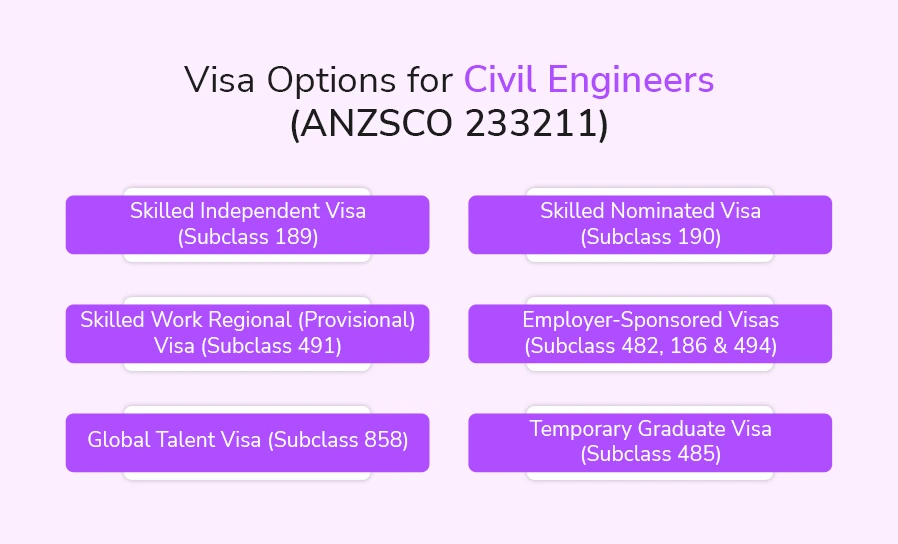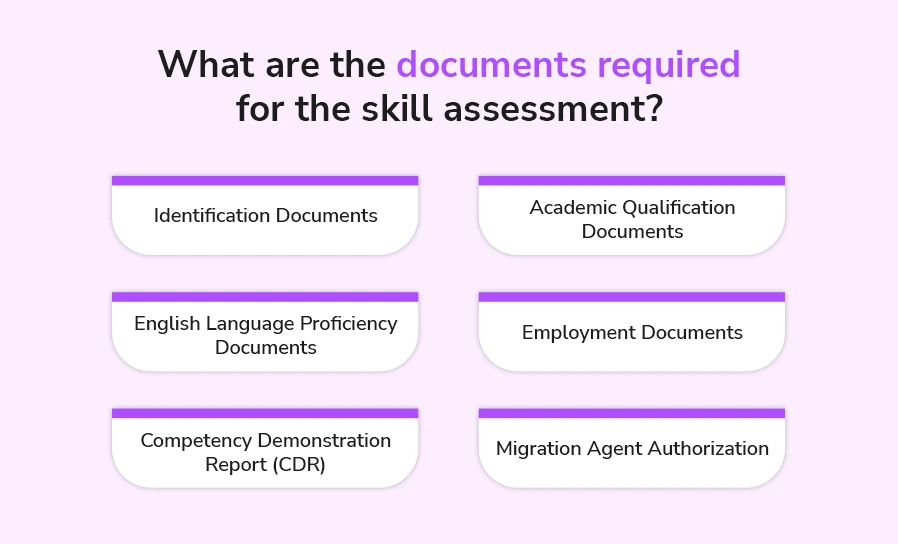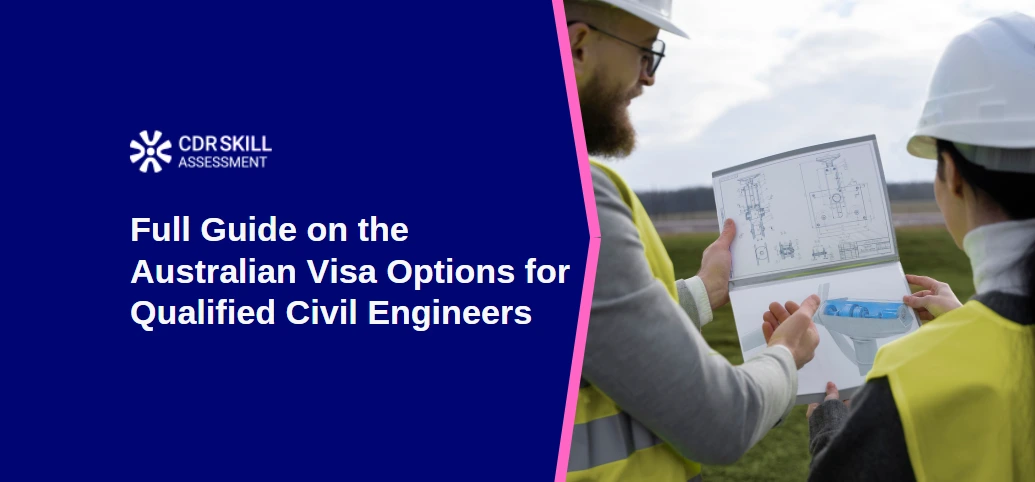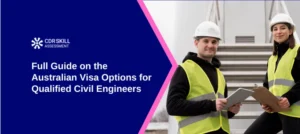Civil engineers find Australia provides them with appealing opportunities to establish their professional careers in foreign lands. Civil engineers, called ANZSCO Code: 233211, receive high demand in Australian markets because of rapidly expanding infrastructure activities. Multiple Australian visa options exist for qualified civil engineers, which facilitates their entry to work and settle in the nation.
The complete guide examines the wide range of Australian visas targeting civil engineers, along with application eligibility specifications and important details for prospective Australian migrants.
Why are civil engineers in demand in Australia? 💭
The Australian construction sector remains active due to transportation expansion, existing energy generation projects, and urban expansion works. The government selects skilled migration as a strategy to solve workforce shortages, while civil engineers drive national infrastructure development.
The following factors show why Australia demands civil engineers:
- Infrastructure projects, including roads, railways and bridges, comprise the essential construction initiatives in Australia.
- Higher population numbers drive housing requirements as well as urban development needs.
- Disaster resilience and climate adaptation initiatives
- The push for sustainable and smart city development.
- Civil engineers maintain regular placement on Australia’s Skilled Occupation List since this demand prompts different pathways for migration
Visa Options for Civil Engineers (ANZSCO 233211) 🤔

1. Skilled Independent Visa (Subclass 189)
Through the Skilled Independent Visa (Subclass 189), skilled workers receive permanent residency in Australia, enabling them to reside anywhere in the country. The visa does not demand either employer sponsorship or referral from a state or territory.
Eligibility Criteria:
- Australian immigration has imposed civil engineering on its Medium and Long-term Strategic Skills List (MLTSSL).
- All applicants need to present their Expressions of Interest to SkillSelect.
- Australian authorities must invite candidates to start their application process.
- Applicants must obtain at least 65 points to receive an invitation from the Australian government. A higher point score improves the chance of invitation success.
- The candidate should not exceed 45 years old during their invitation period.
- The applicant needs to succeed in an assessment administered by Engineers Australia.
- The visa candidate must fulfil the required English language proficiency assessments, which include IELTS and PTE and equivalent certifications.
Processing Time and Benefits
- Processing time: approximately 6 to 12 months.
- Foreign residents obtain permanent residency together with access to full work rights.
- Permanent residents of Australia receive Medicare together with education access and obtain all social security benefits.
- Permanent residents can petition their relatives for future permanent residency.
2. Skilled Nominated Visa (Subclass 190)
A permanent residency visa known as a Subclass 190 Skilled Nominated Visa functions as a result of Australian state or territory nominations. The states maintain separate criteria since they evaluate their workforce needs differently.
Eligibility Criteria:
- The State Nomination List must accept civil engineers as eligible candidates.
- The candidate needs to submit an EOI and receive a state government invitation first.
- You need to satisfy every condition specified by a state, including the basic work duration and residence period. a state
- A positive skills assessment must be obtained from Engineers Australia.
- Meet the points test requirement (usually 65+).
Benefits:
- Priority processing and increased chances of invitation.
- Permanent residents gain unrestricted ability to work and live in Australia.
- State nomination provides an additional 5 points that reinforce your EOI points score.
3. Skilled Work Regional (Provisional) Visa (Subclass 491)
This 5-year Subclass 491 visa provides skilled workers the opportunity to reside and work in all areas designated as regions of Australia. The Subclass 191 visa permits permanent residency after three years of waiting for eligibility for Subclass 491 visa applicants.
Eligibility Criteria:
The eligibility for this visa depends upon state nomination or family member sponsorship from a regional area of Australia.
- The applicant must demonstrate at least 65 points according to the points test criteria.
- Positive skills assessment from Engineers Australia.
- The visa applicant should commit to spending three years doing work and living in selected regional areas of Australia.
Benefits:
- Offers a pathway to permanent residency.
- 15 extra points for state nomination.
- Through the Subclass 191 visa, applicants can access public medical care programmes, together with public governmental services.
4. Employer-Sponsored Visas (Subclass 482, 186 & 494)
a. Temporary Skill Shortage (TSS) Visa (Subclass 482)
Through the Subclass 482 visa, employers gain the power to invite skilled workers to stay and work for four years. People in the civil engineering field need to be on the MLTSSL list at present to access medium-term stream opportunities.
Requirements:
- Australian employers approved by the government extend employment opportunities to professionals.
- Skills assessment or relevant work experience.
- Meet English language requirements.
b. Employer Nomination Scheme (ENS) Visa (Subclass 186)
A permanent employer-sponsored document that started under the name Subclass 186 visa. Civil engineers who seek migration to Australia under the Direct Entry or Temporary Residence Transition stream are eligible to apply.
Requirements:
- Employer sponsorship from an Australian company.
- At least 3 years of work experience (for direct entry).
- Positive skills assessment from Engineers Australia.
- Global immigration authorities issue the Skilled Employer Sponsored Regional (Provisional) Visa (Subclass 494) to qualified candidates.
- The Subclass 494 visa lets regional employers extend sponsorship of civil engineers for five years while granting them a permanent residency option.
Requirements:
- Employer sponsorship from a regional business.
- Skills assessment from Engineers Australia.
- Candidates can apply for permanent residence after staying and working in the regional regions of Australia for three consecutive years
5. Global Talent Visa (Subclass 858)
The Global Talent Visa enables entry into Australia for highly qualified professionals from particular occupational sectors. The visa primarily targets three sectors: advanced manufacturing, infrastructure, and renewable energy, but it allows exceptional civil engineers to make applications.
Requirements:
- The candidate needs to present exceptional attainment during their career as a civil engineer.
- This visa requires an Australian citizen PR holder or an organisation to submit the nomination application.
- High salary threshold (AU$167,500 or above).
6. Temporary Graduate Visa (Subclass 485)
Students who graduated with international civil engineering degrees from Australian universities have the opportunity to get their Subclass 485 visa, which allows them to work in Australia.
Streams:
Graduate Work Stream: For graduates of in-demand occupations (valid for 18 months).
Graduates who complete their studies at an Australian institution under this stream can stay in the country for a duration of two to four years.
Skills Assessment for Civil Engineers (Engineers Australia)
Each civil engineer who wants to obtain a skilled visa needs to get their skills evaluated by Engineers Australia. The assessment pathways include:
Engineers who possess qualifications without accreditation need to prepare Competency Demonstration Reports (CDR) to apply for skilled visas.
The assessment under the Washington Accord enables those who hold degrees from accredited educational institutions to proceed.
Australian Qualifications Pathway: For graduates from Australian universities.
What are the documents required for the skill assessment?📝

A civil engineer applying to Engineers Australia for an assessment must present specific documents that validate their qualifications along with work experience and English proficiency.
Engineers Australia requires the following documents along with their detailed descriptions as listed below for successful assessment completion:
1. Identification Documents
Documents describing your identity along with individual information act as confirmation of your identity.
a. Passport Bio Page
Engineers Australia requires a passport photo page scan that demonstrates your name date of birth and passport number information.
Engineers Australia demands this document as the first essential proof of personal identification.
b. National Identity Card
Individuals who come from India, or the UAE may submit their national ID card as an additional way to verify their identity.
c. Change of Name Document
Submit a name change certificate or affidavit to prove your different name since passport and academic records diverge because of marriage or legal name changes.
2. Academic Qualification Documents
Proof of your educational qualifications in civil engineering appears through these supporting documents.
a. Degree Certificate
A certified copy of your bachelor’s degree in civil engineering (or a higher qualification).
The English translation of your non-English degree certificate needs to come from an official source.
b. Academic Transcripts
Your application should include an official document verification of academic transcripts that shows the following information:
- Subjects studied
- Grades or marks obtained
- Date of completion
c. Course Syllabus (if required)
Professionals at Engineers Australia occasionally request academic syllabi for standard assessment of subject material against Australian engineering requirements.
d. Postgraduate Degree Certificate (if applicable)
When holding a master’s or PhD in civil engineering, you must supply your degree certificate together with your academic records.
Your postgraduate credentials alone are not adequate since Engineers Australia requires your undergraduate degrees for assessment.
3. English Language Proficiency Documents
English proficiency testing using approved exams serves as one of the required steps for students whose primary language is not English.
a. Accepted English tests
IELTS Academic or General (Minimum score: 6.0 in each band)
PTE Academic (Minimum score: 50 in each section)
TOEFL iBT (Minimum overall score: 64, with minimum scores in each section)
b. Exemption from the English Test
People who earned their engineering degree from Australia, Canada, the USA UK, New Zealand or Ireland are exempt from taking an English language exam.
You need to offer documentation that proves enrolment at an English-speaking university through academic transcripts or similar.
4. Employment Documents
To get work experience points for your skilled visa, you need to present valid documents that demonstrate your engineering activities.
a. Employment Reference Letters
An authorised company employee must sign a letter written by the current employer and the former employer, which should be placed on official company stationery.
The letter must include:
- Your job title
- Employment duration (start and end dates)
- The described duties and responsibilities need to match the job description of civil engineer category 233211 according to ANZSCO.
- Work location
- Company contact details
b. Payslips and Tax Records
To prove paid employment, submit:
- Both initial and final pay stubs for every employment period.
- Income tax records (if available)
- Superannuation statements
c. Work Contracts (if applicable)
You must present your employment contracts when authorities request verification of work experiences.
d. Organizational Chart (if required)
Certain job candidates seeking senior roles need to present evidence of their position through an organisational chart of the company.
e. Self-Employment Documents (if applicable)
If you were self-employed, provide:
- Business registration certificate
- Client invoices/contracts
- Tax returns & financial statements
5. Competency Demonstration Report (CDR)
A competency demonstration report (CDR) serves as the proof of skills for candidates who possess engineering degrees that fail to meet Washington Accord accreditation.
a. Three Career Episodes
Each career episode describes a specific engineering project or work experience.
The report needs to showcase your skills in problem-solving methods and innovative engineering solutions together with your deep engineering knowledge.
b. Summary Statement
The summary statement from your career provides direct links to the competency elements of Engineers Australia.
Your success in the assessment depends on Engineers Australia using these documents to evaluate your attainment of Australian engineering standards.
c. Continuing Professional Development (CPD) Report
A one-page report listing:
Your educational development includes workshops and training sessions alongside seminars and engineering courses that assist your skill improvement.
The table includes training dates, entities, and geographical locations.
d. Plagiarism-Free Report
Engineers Australia conducts thorough checks to detect plagiarism in every submission.
Online sample career episodes along with other applicant submissions lack authenticity so do not use them.
6. Migration Agent Authorization
A Migration Agent Authority Form functions as the necessary document for use with migration agents or consultants to allow them to handle professional tasks.
Conclusion
Australia provides several visa options to qualified civil engineers who match ANZSCO 233211. Your success rate in entering Australia will improve when you study the visa requirements and make thoughtful plans for state nominations or independent skilled migration as well as employer sponsorship.
Civil engineers who want to migrate to Australia should determine their eligibility, then get their skills assessment approved by EngineersAustralia, followed by choosing visas according to their qualifications and objectives. The strong demand for civil engineers continues to make Australia an international destination because of its specific pathways to permanent residency.
Personalised details about migration can be obtained through a consultation with a registered migration agent or by referencing information provided through the official Australian immigration website.
FAQs
1. What is the best visa for civil engineers in Australia?
- Skilled Independent Visa (Subclass 189)
- Skilled Nominated Visa (Subclass 190)
- Skilled Work Regional Visa (Subclass 491)
- Employer-Sponsored Visas (Subclass 482, 186, 494)
- Global Talent Visa (Subclass 858)
2. What is anzsco 233211 engineers Australia?
ANZSCO 233 refers to specialists who plan, design, and oversee the construction of infrastructure projects such as roads, bridges, tunnels, buildings, and water systems.
3. Is civil engineering on the PR list in Australia?
Yes, civil engineering is on the PR list in Australia.
4. Which job is better for a civil engineer?
The best job depends upon your qualifications and interests. Some of the top engineering jobs are listed below:
- Structural Engineer
- Marine Engineer
- Project Engineer
- Geotechnical Engineer, etc.
5. What is the highest level of Anzsco?
The highest level of ANZSCO is skill level 1.


